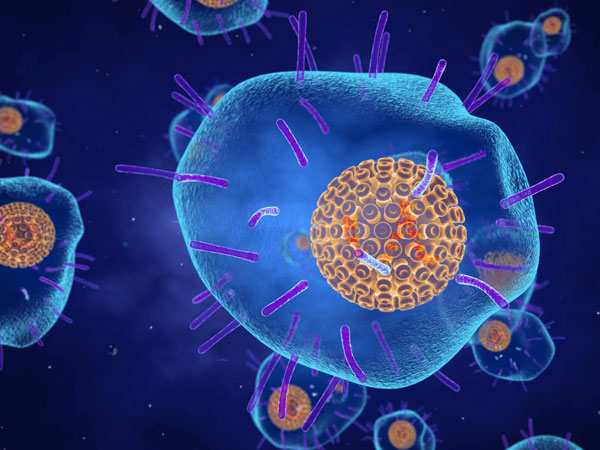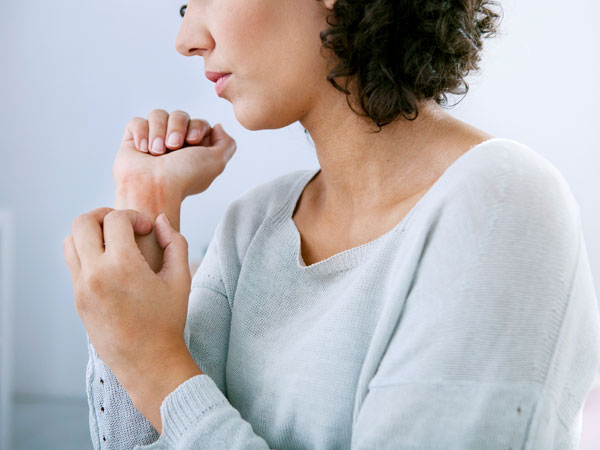- Home
- Science
- Diseases & Conditions
- Shingles
What Is Shingles?
Shingles, also called herpes zoster, is a painful rash that occurs on one side of the face or body and is caused by the varicella zoster virus, which is also responsible for chickenpox.1,2 People of any age can get chickenpox.2 When a person gets chickenpox and recovers, the varicella zoster virus remains dormant in their nerve cells. Later in life, it can reactivate, causing shingles.3
Shingles tends to occur in older adults or in people with a weakened immune system. As a person ages and/or their immune system becomes less effective, the virus can reactivate, migrating from nerve cells to the skin, producing the shingles rash.2,3
If a person who has never had chickenpox is exposed to someone who has an active shingles infection, they may get chickenpox—not shingles.4
Prevalence of Shingles
Shingles is a common condition. About one in every three people experiences a case in their lifetime, and most who do only experience it once. The disease is more common in older people, and the overall risk of shingles increases with age.5
Shingles can have serious consequences. For example, between 10% and 18% of patients experience postherpetic neuralgia,3 which is pain that can linger for months or years after the rash clears.3,6 Complications may require hospitalization in 1% to 4% of patients with shingles. Among patients hospitalized with shingles, 30% have weakened or suppressed immune systems.5
Shingles is rarely fatal, resulting in fewer than 100 deaths each year in the U.S. Nearly all these deaths occur among older people or those whose immune systems are weak.5
Prior to the availability of a shingles vaccine in 2006,7 shingles rates had been increasing in the U.S. For example, in 1998, the country’s incidence rate of shingles was about four cases for every 1,000 adults aged 30 and older. This rate climbed to close to six cases for every 1,000 people by 2016.5 Since 2016, the overall incidence in the U.S. has declined, particularly in older adults.5,8
The Centers for Disease Control and Prevention recommends shingles vaccination for adults age 50 and up and immunocompromised adults age 19 and up.9 According to the Centers for Disease Control and Prevention, nearly 35% of adults age 60 and up received the vaccine in 2018. That was an increase from about 7% in 2008.10 However, shingles vaccination rates among certain groups in the U.S. lag behind others. For example, older adults who are Black or Hispanic are about 50% less likely to be vaccinated for shingles compared with non-Hispanic white adults in the U.S.11
Causes and Risk Factors
What Causes Shingles?

Shingles is caused by the varicella zoster virus. The same virus also causes chickenpox.2,12 Though the source virus is the same, chickenpox and shingles are two different illnesses, and chickenpox tends to be less severe.13
Shingles is caused by the reactivation of varicella zoster virus.2 Those who have had and recovered from chickenpox can develop shingles.2,12 When the chickenpox virus reactivates, the term for the resulting illness is herpes zoster, or shingles.12
Shingles typically develops as follows. After a person recovers from chickenpox, the varicella zoster virus lingers in their nerve cells. The virus can then reactivate later in life as the immune system weakens. When the immune system weakens, it loses its ability to keep the virus in check. Having an immune system that is compromised for reasons other than aging can also increase a person’s likelihood of getting shingles.2,3,12
Shingles Risk Factors
Shingles may occur in individuals who have previously contracted chickenpox, which is true of 99.5% of people born before 1980. It may also occur in those who received a live chickenpox vaccine. But the risk of developing shingles is lower for people who have had the chickenpox vaccine than it is for people who contracted the virus through natural exposure.3
Overall, a person’s shingles risk increases as their immunity declines. This can stem from the natural aging process, so that, overall, shingles risk rises with increasing age.3,5
But other factors can also weaken a person’s immune system, such as immunosuppressive medications, organ transplants, cancers, and other types of pharmaceuticals—all of which can increase shingles risk.3,12 Specific factors that may weaken the immune system and contribute to the development of shingles also include chemotherapy treatment and diseases such as HIV/AIDS.3,12
Research indicates that stress may also be a risk factor for shingles.14
Shingles Prevention
Vaccination is an effective way to prevent shingles. According to The Centers for Disease Control and Prevention (CDC), the currently recommended shingles vaccine was 97% effective in preventing shingles in healthy adults aged 50 to 69 and 91% effective for adults aged 70 and older.9 The CDC recommends that adults aged 50 and older receive two doses of this shingles vaccine between two and six months apart, regardless of whether they’ve previously had chickenpox or shingles.9
According to the CDC, shingles vaccination is also recommended for adults with compromised immune systems who are 19 and older. This recommendation applies only to patients with a prior history of chickenpox or of chickenpox vaccination, who have a risk of developing shingles.15
Vaccination is also available for chickenpox (varicella zoster),16 the virus that causes shingles.3 Like the shingles vaccine, the chickenpox vaccine is administered in two doses, the timing of which may vary. The CDC recommends that children under the age of 13 receive two doses, with the first dose occurring around 12 to 13 months of life and the second occurring around the ages of 4 to 6 years. For people age 13 or older who have never contracted chickenpox or been vaccinated, the CDC recommends two doses with a minimum of 28 days between them.16 Specific recommendations have been developed for chickenpox vaccination of individuals with compromised immune systems.17
Shingles Signs and Symptoms

Shingles may begin as pain that shoots or burns, but it can also start with a tingling or itching feeling. After a few days, the rash emerges. Blisters form as part of the rash and scab in seven to 10 days.1,12
The rash tends to take a consistent shape, emerging as a stripe that goes around the body’s right or left side.1 The area in which the rash erupts tends to follow specific nerve connections to the spine. It does not tend to cross the midline of the body.3,15
Rarely, the rash can be more widespread, resembling chickenpox. This is more typical in people with compromised immune systems.12 Full healing of the rash and blisters typically takes two to four weeks.3
Pain is a common shingles symptom. Patients sometimes describe it as a shooting or burning sensation, but it also can present as tingling or itching.12
Following the onset of these sensations, the shingles rash typically emerges.12
In addition to the rash, other accompanying symptoms can include fever, headache, and upset stomach.12 Some shingles patients also report light sensitivity and malaise prior to the appearance of the rash.3
Shingles Complications

Postherpetic neuralgia is the most common shingles complication.3 It is pain that may linger in the affected area for three months or longer after the shingles rash appears.18 The more pain a person experiences and the larger the size of the rash, the more likely they are to develop postherpetic neuralgia.3
The risk of postherpetic neuralgia increases with age. For example, between 10% and 13% of people aged 60 and over who have shingles will experience postherpetic neuralgia. By comparison, postherpetic neuralgia occurs in fewer than 5% of cases in people who are under the age of 50 and contract shingles.3,5,18,19,20
Shingles can also present as ophthalmic shingles—a rash on either or both eyelids. The rash and subsequent blisters can drain and sometimes produce redness or burning in one or both eyes. Cases of ophthalmic shingles can also lead to light sensitivity, blurred vision, redness, pain, or swelling. The disease can even damage the cornea, which is the dome-like structure at the front of the eye that focuses light.3,21
Other possible complications include:
- Hearing loss22
- Bacterial infection of the lesions3
- Cranial and peripheral nerve palsy,3 which can lead to partial or total paralysis of certain parts of the face23
- Effects to the body and nervous system,3 such as meningoencephalitis (the inflammation of certain structures in the brain)24, pneumonitis (irritation or inflammation of lung tissue)25, hepatitis (inflammation in liver tissue)26, and acute retinal necrosis (tissue death in the eyes)27
Diagnosis and Treatment
Shingles Diagnosis
To diagnose shingles, healthcare providers often look for the presence of the characteristic rash. Without a rash, shingles may be challenging to diagnose.28
Cases in young adults, children, and people with compromised immune systems can be challenging to diagnose because shingles sometimes does not follow the same symptom patterns in these groups. In such cases, a healthcare provider may order a diagnostic test called a PCR test to identify the presence of shingles.28
Finally, shingles can be mistaken for other conditions, such as:28
A viral infection that causes ulceration or blistering of the skin29
An infection of the skin caused by bacteria30
Irritation of the skin resulting from contact with a foreign substance31
A mite infestation of the skin32
Shingles Treatment
Shingles treatment options consist of self-care combined with certain over-the-counter and prescribed medications.4
For self-care, a healthcare provider may advise you to take a lukewarm oatmeal bath, apply calamine lotion, or use wet compresses to soothe discomfort from the rash. They may also recommend over-the-counter pain relievers.4
In certain cases, healthcare providers may prescribe pain medication or may prescribe antiviral medications, which may shorten the duration and severity of shingles. These medications must be initiated close to the onset of the rash.4
Global Impact of Shingles

Globally, an estimated three to five people out of every 1,000 will get shingles each year. People who are unvaccinated and live to the age of 85 have a 50% chance of developing the disease in their lifetime.33
In high-income countries, rates of shingles are similar to those observed in the United States. In low- and middle-income countries, shingles data are limited, making it difficult to gauge the burden of disease.34
Currently, two versions of the shingles vaccine are available around the world. One uses a live version of the virus and the other, called the recombinant vaccine, is based on elements of the viral protein.35 As of 2020, the live vaccine was approved for use in approximately 60 countries around the world. However, the recombinant vaccine showed higher efficacy in clinical trials. It is approved in more than 30 countries, including the U.S., Canada, Japan, Australia, China, and the European Union.34 Certain barriers prevent the widespread global uptake of shingles vaccines. Some countries do not recommend the vaccines, while other countries do not promote them with funding or public education.34
Frequently Asked Questions About Shingles
- Is shingles contagious?
Shingles originates with a contagious virus: varicella zoster, which also causes chickenpox. When a person contracts chickenpox and recovers, the virus remains inactive in their nerve cells. It may reactivate later in their life as shingles.2,3,4
When a person has shingles, the rash or the blister fluid can transmit the virus through contact or air to people who have not had the virus previously, or who have not received the chickenpox vaccine. If these people become ill, they will be sick with chickenpox, not shingles. However, these people may develop shingles later in life.2,4
- What is shingles?
Shingles is a painful rash that appears on one side of the body or face.1 It occurs when the chickenpox virus (varicella zoster) becomes active again later in life. When this happens, the corresponding condition is called shingles (herpes zoster).3
Shingles typically develops as follows: A person contracts chickenpox early in life and heals, and then the virus lies dormant, resting in their nerve cells before reactivating later on.2,3
Shingles tends to affect older adults and/or people with weakened immune systems. Waning immunity allows for the reactivation of the virus, which travels from the nerve cells to the skin, resulting in the characteristic shingles rash.2,3
Approximately one in every three people in the U.S. will likely contract shingles in their lifetime.3,5 The rate of shingles in the U.S. had been increasing before the introduction of the varicella vaccine, which slowed the trend.5,8 It’s atypical for a person to contract shingles more than once.5
Vaccines are available to prevent shingles and chickenpox.3
- How long does shingles last?
Generally, it takes a week to 10 days for shingles blisters to dry and crust and then another two weeks for the scabs to clear.1,12
The progression of the virus can begin with a number of sensations, such as pain, tingling, burning, or itching.2,12 Within a few days later, the rash emerges, which involves fluid-filled blisters.1,3,12
- How do you get shingles?
Shingles is caused by the same virus as chickenpox. A person gets chickenpox earlier in life and then recovers. Even though they are no longer visibly sick, the virus is still in their body, residing in the nerve cells. The virus may reactivate later in life as shingles.2,4
While a person is sick with shingles, the rash or fluid from the blisters can spread the virus through contact or inhalation to people who have not had chickenpox or the chickenpox vaccine. If they get sick, it will be with chickenpox, not shingles. They may have shingles later in life, however.2,4
- Can you get shingles if you never had chickenpox?
No, you cannot get shingles if you have never had chickenpox or the chickenpox vaccine.4 This is because the same virus, varicella zoster, causes chickenpox and shingles. In order to have shingles, a person must contract the virus, experience chickenpox, then recover. The virus then lingers in the nerve cells, though it may not cause illness until later in life, when it reactivates as shingles.2-4 In some cases, people who have never had chickenpox, but who received the chickenpox vaccine, can get shingles.3
Regardless of how old you are, you can come down with chickenpox if you’ve never had it or been vaccinated before.2 And if a person who has not contracted chickenpox encounters someone who is sick with shingles, they could contract chickenpox—not shingles.4 Only later in life, after they’ve recovered from chickenpox, might they have shingles.2
- Can you get shingles more than once?
Typically, people who contract shingles only have the condition once, but it is possible to get it more than once.4,5
Learn More About Shingles
Find a Pfizer clinical trial for shingles at PfizerClinicalTrials.com.
Explore shingles clinical trials at ClinicalTrials.gov.
Area of Focus: Vaccines
Shingles is a focus of Pfizer’s Vaccines Therapeutic Area. Visit the Vaccines Page.
- References
- Shingles Symptoms and Complications. Shingles (Herpes Zoster). Centers for Disease Control and Prevention. https://www.cdc.gov/shingles/signs-symptoms/. Updated July 1, 2019. Accessed April 16, 2024.
- Clinical Overview of Chickenpox (Varicella). For healthcare professionals. Centers for Disease Control and Prevention. https://www.cdc.gov/chickenpox/hcp/clinical-overview/. Updated October 21, 2022. Accessed April 16, 2024.
- Clinical Overview of Shingles (Herpes Zoster). Centers for Disease Control and Prevention. https://www.cdc.gov/shingles/hcp/clinical-overview/. Updated October 5, 2020. Accessed April 16, 2024.
- About Shingles (Herpes Zoster). Centers for Disease Control and Prevention. https://www.cdc.gov/shingles/about/. Updated May 10, 2023. Accessed April 16, 2024.
- Shingles Facts and Stats. Centers for Disease Control and Prevention. https://www.cdc.gov/shingles/data-research/. Updated August 14, 2019. Accessed April 16, 2024.
- Postherpetic neuralgia—aftercare. MedlinePlus. https://medlineplus.gov/ency/patientinstructions/000555.htm. Updated May 12, 2022. Accessed April 16, 2024.
- Baxter R, Bartlett J, Fireman B, et al. Long-term effectiveness of the live zoster vaccine in preventing shingles: a cohort study. American Journal of Epidemiology. 2018;187(1):161-169.
- Leung J, Dooling K, Marin M, Anderson TC, Harpaz R. The Impact of Universal Varicella Vaccination on Herpes Zoster Incidence in the United States: Comparison of Birth Cohorts Preceding and Following Varicella Vaccination Program Launch. J Infect Dis. 2022;226(Suppl 4):S470-S477.
- Shingles Vaccination. Centers for Disease Control and Prevention. https://www.cdc.gov/vaccines/vpd/shingles/public/shingrix/index.html. Updated May 24, 2022. Accessed April 16, 2024.
- Terlizzi E, Black L. Shingles vaccination among adults aged 60 and over: United States, 2018. U.S. NCHS Data Brief. Department of Health and Human Services. Centers for Disease Control and Prevention. https://www.cdc.gov/nchs/data/databriefs/db370-h.pdf. July 2020.
- Vogelsang EM, Polonijo AN. Social determinants of shingles vaccination in the United States. Kelley J, ed. The Journals of Gerontology: Series B. 2022;77(2):407-412.
- Shingles. MedlinePlus. https://medlineplus.gov/shingles.html. Updated March 29, 2023. Accessed April 16, 2024.
- Chickenpox versus shingles—What’s the difference? Association for Professionals in Infection Control and Epidemiology. https://apic.org/Resource_/TinyMceFileManager/for_consumers/IPandYou_Bulletin_Chicken_Pox_and_Shingles.pdf. Accessed April 22, 2024.
- Takao Y, Okuno Y, Mori Y, Asada H, Yamanishi K, Iso H. Associations of perceived mental stress, sense of purpose in life, and negative life events with the risk of incident herpes zoster and postherpetic neuralgia. American Journal of Epidemiology. 2018;187(2):251-259.
- Anderson TC, Masters NB, Guo A, et al. Use of Recombinant Zoster Vaccine in Immunocompromised Adults Aged ≥19 Years: Recommendations of the Advisory Committee on Immunization Practices — United States, 2022. MMWR Morb Mortal Wkly Rep 2022;71:80–84.
- Chickenpox vaccination: What everyone should know. Centers for Disease Control and Prevention. https://www.cdc.gov/vaccines/vpd/varicella/public/index.html. April 28, 2021. Accessed April 16, 2024.
- Marin M, Güris D, Chaves SS, Schmid S, Seward JF; Advisory Committee on Immunization Practices; CDC. Prevention of varicella: recommendations of the Advisory Committee on Immunization Practices (ACIP). MMWR Recomm Rep 2007;56(RR-4):1–40.
- Gruver C, Guthmiller K. Postherpetic neuralgia. StatPearls. https://www.ncbi.nlm.nih.gov/books/NBK493198/. Updated February 12, 2023. Accessed April 16, 2024.
- Forbes HJ, Bhaskaran K, Thomas SL, et al. Quantification of risk factors for postherpetic neuralgia in herpes zoster patients: A cohort study. Neurology. 2016;87(1):94-102.
- Opstelten W. Herpes zoster and postherpetic neuralgia: incidence and risk indicators using a general practice research database. Family Practice. 2002;19(5):471-475.
- Boyd K. What is shingles? American Academy of Ophthalmology. https://www.aao.org/eye-health/diseases/herpes-zoster-shingles. Updated September 9, 2022. Accessed April 16, 2024.
- Kim CH, Choi H, Shin JE. Characteristics of hearing loss in patients with herpes zoster oticus. Medicine. 2016;95(46):e5438.
- Walker N, Mistry R, Mazzoni T. Facial nerve palsy. StatPearls. https://www.ncbi.nlm.nih.gov/books/NBK549815/. Accessed June 28, 2023. Updated April 16, 2024.
- Sapra H. Managing meningoencephalitis in Indian ICU. Indian Journal of Critical Care Medicine. 2019;23(S2):124-128.
- Pneumonitis. National Cancer Institute. https://www.cancer.gov/publications/dictionaries/cancer-terms/def/pneumonitis. Accessed April 16, 2024.
- Overview of Viral Hepatitis for Health Care Professionals. Centers for Disease Control and Prevention. https://www.cdc.gov/hepatitis/resources/healthprofessionaltools/ABCofViralHepatitis.htm#. Accessed June 28, 2023. Updated March 9, 2023.
- Acute retinal necrosis. Clinical Info HIV.gov. https://clinicalinfo.hiv.gov/en/glossary/acute-retinal-necrosis-arn. Accessed April 16, 2024.
- Laboratory Testing for Varicella-Zoster Virus (VZV). Shingles (herpes zoster). Centers for Disease Control and Prevention. https://www.cdc.gov/chickenpox/php/laboratories/? Updated September 19, 2019. Accessed April 16, 2024.
- Herpes simplex virus. World Health Organization. https://www.who.int/news-room/fact-sheets/detail/herpes-simplex-virus. Accessed June 28, 2023. Updated April 16, 2024.
- About Impetigo. Centers for Disease Control and Prevention. https://www.cdc.gov/group-a-strep/about/impetigo.html Accessed June 28, 2023. Updated April 16, 2024.
- Contact dermatitis. American College of Allergy, Asthma & Immunology. https://acaai.org/allergies/allergic-conditions/skin-allergy/contact-dermatitis/. Accessed April 16, 2024.
- About Scabies. Centers for Disease Control and Prevention. https://www.cdc.gov/scabies/about/? Accessed April 16, 2024. Updated September 1, 2020.
- Dalli LL, Kim J, Kilkenny MF. Vaccination against herpes zoster and the potential to reduce the global burden of stroke. Stroke. 2021;52(5):1722-1723.
- Pan CX, Lee MS, Nambudiri VE. Global herpes zoster incidence, burden of disease, and vaccine availability: A narrative review. Therapeutic Advances in Vaccines and Immunotherapy. 2022;10:251513552210845.
- Harbecke R, Cohen JI, Oxman MN. Herpes zoster vaccines. The Journal of Infectious Diseases. 2021;224(Supplement_4):S429-S442.
The information contained on this page is provided for your general information only. It is not intended as a substitute for seeking medical advice from a healthcare provider. Pfizer is not in the business of providing medical advice and does not engage in the practice of medicine. Pfizer under no circumstances recommends particular treatments for specific individuals and in all cases recommends consulting a physician or healthcare center before pursuing any course of treatment.

